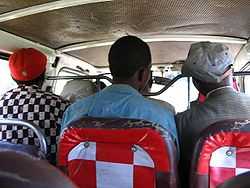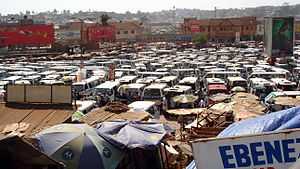Matatu

In Kenya and neighbouring nations, matatu (or matatus) are privately owned minibuses although pick-up trucks were in the past pressed into service as these East African share taxis.[1] Often decorated, many matatu feature portraits of the famous or slogans and sayings.[2] The music they play is also aimed at quickly attracting riders.[3]
These minibuses ply set routes, run from termini, and are used for both inter and intra-city travel.[4] In addition to a driver, matatu may be staffed by a conductor.[5]
As of 1999 they were the only form of public transport available in Nairobi, Kenya, although in 2006 and 2008 this was no longer the case.[6] Kampala, Uganda, may only be serviced by minibuses as of 2008.[AICD 1]
Etymology
The name is a Swahili colloquialism.[7] One explanation is that, as the word tatu means three, the name derives from the long wheelbase Peugeot model 504 estate, called the break, which could be fitted with three rows of bench seats and carry 10 or more passengers. It is true that this particular model is associated with this form of share taxi.[8]
Kenyan regulation
In Kenya this industry is regulated, and these minibuses must be fitted with seatbelts and speed governors.[9] The Kenyan regime has been described as having extensive regulatory controls, and in this country a matatu worker can be pulled from the streets simply for sporting too loud a shirt.[10]
Present regulation may not be sufficient deterrent to prevent small infractions, as even decoration may be prohibited.[11]
As of December 2010, Kenyan Government policy is to phase out minibus matatu in favour of larger, 25+ seat buses. It could take ten years to clear the much smaller minibus from Nairobi streets, however.[12] As of early 2012, there may be few matatu stations remaining in central Nairobi as a result of anti-matatu regulation. Regardless, the minibus is still the primary form of transport in the city.[13]
Ugandan regulation

As of 2008, Kampala, Uganda, has no independent transport authority.[AICD 2]
See also
References
- ↑ For Kenya and neighbouring nations, see Kenya's Taxi Vans Are Packed and Perilous nytimes.com, 24 April 1988
- For private ownership, see In Nairobi, Kenya puts brakes on its runaway success csmonitor.com, 28 June 1999
- For matatu as minibuses, see Kenya (page 383) Tom Parkinson, Max Phillips, Will Gourlay. Lonely Planet, 2006. 416 pages. 1740597435, 9781740597432. (Google Books)
- For past use of pick-up trucks, see Have You Ever Taken A Matatu? glpinc.org
- ↑ For portraits, see Nairobi Today: the Paradox of a Fragmented City; Hidden $ Centz: Rolling the Wheels of Nairobi Matatu. Mbugua wa-Mungai. (page 376) edited by Helene Charton-Bigot, Deyssi Rodriguez-Torres. African Books Collective, 2010. 404 pages. 9987080936, 9789987080939. (Google Books)
- For slogans and sayings, see Roll over Snoop Dogg, Ocampo is new king of the matatu csmonitor.com, 29 January 2010
- ↑ DJ Edu (21 February 2015). "The buses you choose because of their music". Radio 1Xtra. BBC. Retrieved 1 March 2015.
- ↑ For set routes, see Kenya (page 382) Tom Parkinson, Max Phillips, Will Gourlay. Lonely Planet, 2006. 352 pages. 1740597435, 9781740597432. (Google Books)
- For termini, see Nairobi Today: the Paradox of a Fragmented City; Hidden $ Centz: Rolling the Wheels of Nairobi Matatu. Mbugua wa-Mungai. (page 374) edited by Helene Charton-Bigot, Deyssi Rodriguez-Torres. African Books Collective, 2010. 404 pages. 9987080936, 9789987080939. (Google Books)
- For intra and inter-city travel, see Negotiating social space: East African microenterprises (page 69) Patrick O. Alila, Poul O. Pedersen. Africa World Press, 2001. 353 pages. 0865439648, 9780865439641. (Google Books)
- ↑ Nairobi Today: the Paradox of a Fragmented City; Hidden $ Centz: Rolling the Wheels of Nairobi Matatu. Mbugua wa-Mungai. (page 371) edited by Helene Charton-Bigot, Deyssi Rodriguez-Torres. African Books Collective, 2010. 404 pages. 9987080936, 9789987080939. (Google Books)
- ↑ For 1999 matatu as sole form of public transport, see In Nairobi, Kenya puts brakes on its runaway success csmonitor.com, 28 June 1999
- For 2006 other forms of public transport available, see Kenya (page 382) Tom Parkinson, Max Phillips, Will Gourlay. Lonely Planet, 2006. 352 pages. 1740597435, 9781740597432. (Google Books)
- For 2008 other forms of public transport available, see Stuck in Traffic; Urban Transport in Africa (page 6) Ajay Kumar & Fanny Barrett. Africa Infrastructure Country Diagnostic in co-operation with the World Bank, January 2008. Draft Final Report.
- ↑ Nairobi Journal; Take (On) the Minibuses, if You Dare nytimes.com, 16 April 1996
- ↑ Muyia, Nafukho. "The Forgonen Workers" (PDF). Social Science Research Report Series, no. 18. Organization for Social Science Research in Eastern and Southern Africa. p. 7. Retrieved 25 September 2012.
- ↑ Kenya (page 383) Tom Parkinson, Max Phillips, Will Gourlay. Lonely Planet, 2006. 352 pages. 1740597435, 9781740597432. (Google Books)
- ↑ For extensive Kenyan regulatory control, see Stuck in Traffic; Urban Transport in Africa (page 14) Ajay Kumar & Fanny Barrett. Africa Infrastructure Country Diagnostic in co-operation with the World Bank, January 2008. Draft Final Report.
- For loud shirts as illegal, see Nairobi Today: the Paradox of a Fragmented City; Hidden $ Centz: Rolling the Wheels of Nairobi Matatu. Mbugua wa-Mungai. (page 376) edited by Helene Charton-Bigot, Deyssi Rodriguez-Torres. African Books Collective, 2010. 404 pages. 9987080936, 9789987080939. (Google Books)
- ↑ For regulation as insufficient deterrent, see Nairobi Today: the Paradox of a Fragmented City; Hidden $ Centz: Rolling the Wheels of Nairobi Matatu. Mbugua wa-Mungai. (page 367) edited by Helene Charton-Bigot, Deyssi Rodriguez-Torres. African Books Collective, 2010. 404 pages. 9987080936, 9789987080939. (Google Books)
- For decoration being prohibited, see Nairobi Today: the Paradox of a Fragmented City; Hidden $ Centz: Rolling the Wheels of Nairobi Matatu. Mbugua wa-Mungai. (page 371) edited by Helene Charton-Bigot, Deyssi Rodriguez-Torres. African Books Collective, 2010. 404 pages. 9987080936, 9789987080939. (Google Books)
- ↑ New rules to rein in wild sector nation.co.ke, Friday, 31 December 2010
- ↑ "Ma3, a band inspired by matatu". [Africa]. 27 February 2012. BBC World Service.
- ↑ Stuck in Traffic; Urban Transport in Africa (page 6) Ajay Kumar & Fanny Barrett. Africa Infrastructure Country Diagnostic in cooperation with the World Bank, January 2008. Draft Final Report.
- ↑ Barrett & Kumar, page 14